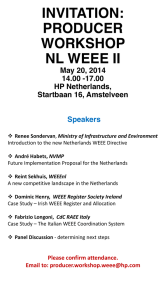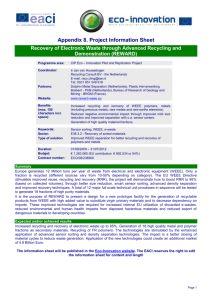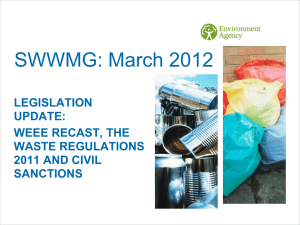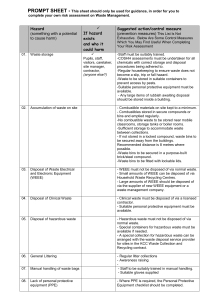Ecodesign - Sustainable Product Development
advertisement
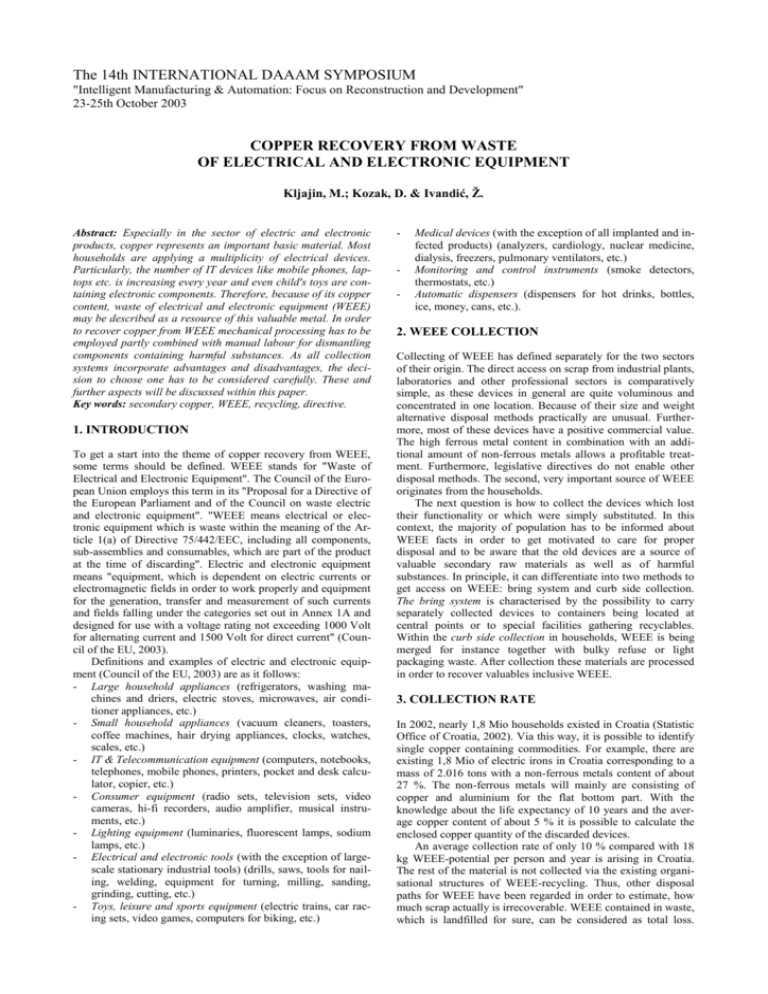
The 14th INTERNATIONAL DAAAM SYMPOSIUM "Intelligent Manufacturing & Automation: Focus on Reconstruction and Development" 23-25th October 2003 COPPER RECOVERY FROM WASTE OF ELECTRICAL AND ELECTRONIC EQUIPMENT Kljajin, M.; Kozak, D. & Ivandić, Ž. Abstract: Especially in the sector of electric and electronic products, copper represents an important basic material. Most households are applying a multiplicity of electrical devices. Particularly, the number of IT devices like mobile phones, laptops etc. is increasing every year and even child's toys are containing electronic components. Therefore, because of its copper content, waste of electrical and electronic equipment (WEEE) may be described as a resource of this valuable metal. In order to recover copper from WEEE mechanical processing has to be employed partly combined with manual labour for dismantling components containing harmful substances. As all collection systems incorporate advantages and disadvantages, the decision to choose one has to be considered carefully. These and further aspects will be discussed within this paper. Key words: secondary copper, WEEE, recycling, directive. 1. INTRODUCTION To get a start into the theme of copper recovery from WEEE, some terms should be defined. WEEE stands for "Waste of Electrical and Electronic Equipment". The Council of the European Union employs this term in its "Proposal for a Directive of the European Parliament and of the Council on waste electric and electronic equipment". "WEEE means electrical or electronic equipment which is waste within the meaning of the Article 1(a) of Directive 75/442/EEC, including all components, sub-assemblies and consumables, which are part of the product at the time of discarding". Electric and electronic equipment means "equipment, which is dependent on electric currents or electromagnetic fields in order to work properly and equipment for the generation, transfer and measurement of such currents and fields falling under the categories set out in Annex 1A and designed for use with a voltage rating not exceeding 1000 Volt for alternating current and 1500 Volt for direct current" (Council of the EU, 2003). Definitions and examples of electric and electronic equipment (Council of the EU, 2003) are as it follows: - Large household appliances (refrigerators, washing machines and driers, electric stoves, microwaves, air conditioner appliances, etc.) - Small household appliances (vacuum cleaners, toasters, coffee machines, hair drying appliances, clocks, watches, scales, etc.) - IT & Telecommunication equipment (computers, notebooks, telephones, mobile phones, printers, pocket and desk calculator, copier, etc.) - Consumer equipment (radio sets, television sets, video cameras, hi-fi recorders, audio amplifier, musical instruments, etc.) - Lighting equipment (luminaries, fluorescent lamps, sodium lamps, etc.) - Electrical and electronic tools (with the exception of largescale stationary industrial tools) (drills, saws, tools for nailing, welding, equipment for turning, milling, sanding, grinding, cutting, etc.) - Toys, leisure and sports equipment (electric trains, car racing sets, video games, computers for biking, etc.) - - Medical devices (with the exception of all implanted and infected products) (analyzers, cardiology, nuclear medicine, dialysis, freezers, pulmonary ventilators, etc.) Monitoring and control instruments (smoke detectors, thermostats, etc.) Automatic dispensers (dispensers for hot drinks, bottles, ice, money, cans, etc.). 2. WEEE COLLECTION Collecting of WEEE has defined separately for the two sectors of their origin. The direct access on scrap from industrial plants, laboratories and other professional sectors is comparatively simple, as these devices in general are quite voluminous and concentrated in one location. Because of their size and weight alternative disposal methods practically are unusual. Furthermore, most of these devices have a positive commercial value. The high ferrous metal content in combination with an additional amount of non-ferrous metals allows a profitable treatment. Furthermore, legislative directives do not enable other disposal methods. The second, very important source of WEEE originates from the households. The next question is how to collect the devices which lost their functionality or which were simply substituted. In this context, the majority of population has to be informed about WEEE facts in order to get motivated to care for proper disposal and to be aware that the old devices are a source of valuable secondary raw materials as well as of harmful substances. In principle, it can differentiate into two methods to get access on WEEE: bring system and curb side collection. The bring system is characterised by the possibility to carry separately collected devices to containers being located at central points or to special facilities gathering recyclables. Within the curb side collection in households, WEEE is being merged for instance together with bulky refuse or light packaging waste. After collection these materials are processed in order to recover valuables inclusive WEEE. 3. COLLECTION RATE In 2002, nearly 1,8 Mio households existed in Croatia (Statistic Office of Croatia, 2002). Via this way, it is possible to identify single copper containing commodities. For example, there are existing 1,8 Mio of electric irons in Croatia corresponding to a mass of 2.016 tons with a non-ferrous metals content of about 27 %. The non-ferrous metals will mainly are consisting of copper and aluminium for the flat bottom part. With the knowledge about the life expectancy of 10 years and the average copper content of about 5 % it is possible to calculate the enclosed copper quantity of the discarded devices. An average collection rate of only 10 % compared with 18 kg WEEE-potential per person and year is arising in Croatia. The rest of the material is not collected via the existing organisational structures of WEEE-recycling. Thus, other disposal paths for WEEE have been regarded in order to estimate, how much scrap actually is irrecoverable. WEEE contained in waste, which is landfilled for sure, can be considered as total loss. Waste processed in recycling and incineration plants allows the recovery of metallic items. These scrap products as rule further are treated in shredder plants. However, as the yield of nonferrous metals in the final products – especially the copper yield – scarcely can be determined, a quantification of metal recovery practically is impossible. Kind of device Coffee machine Washing machine Dishwasher Tumble-drier Radio Boiler Desk lamp Electric iron Hair-dryer Monitor Personal computer Refrigerator Keyboard Vacuum cleaner Computers (older) Microwave Average Average weight in kg 1,33 75,00 50,00 35,00 2,00 1,13 0,37 1,12 0,41 12,00 24,00 38,00 0,52 5,00 27,00 20,00 18,31 Copper content in % 1,60 1,13 1,50 2,57 2,00 1,90 0,70 5,00 21,00 8,75 6,92 4,10 7,00 2,00 7,10 4,80 4,34 Table 1. Average weight and copper content in some devices Actual estimations suppose an annually amount of WEEE for Croatia of about 373.565 tons (Statistic Office of Croatia, 2002). Thus, based on the population number in Croatia per inhabitant approximately 18 kg/a are arising. As electrical and electronic goods more and more frequently are used, yearly increasing rates of 5-10 % of WEEE can be expected (Büttgen, 2000). Some calculations have been performed to define the content of copper in WEEE, which should be an average number and valid for the term WEEE. These numbers of different sources vary between 7,8 and 10,73 % (Bertram, M., 2001; Hedemalm et al., 1995). Nevertheless, the data about electrical household equipment and its copper content in Croatia shows an average of about 5 % of copper in WEEE. That means about 18.678 t/a of copper or about 31 Mio USD/a. The price for copper is about 1,66 USD/kg (LME, 2003). The financial aspect is another argument to underline the great importance of copper recycling from WEEE. With this, just the copper content in the WEEE represents a value of about 310 million USD during the next 10 years. When disregarding the life expectancy of the products, the potential of WEEE can be deduced from these production data. However, of course, products have different life expectancies, which need further consideration. Moreover, many products are only produced to substitute older products. As a rule, older products are bigger and contain more copper than their replacements. If the amount of WEEE originating from the Information Technology sector is taken into account, an increasing quantity of WEEE can be deduced. This will be intensified by a decreasing lifetime expectancy of such products. Within this calculation, the life expectancy of products is not considered. However, it is well conceivable that in the next years such a quantity of scrap will arise. In order to demonstrate the growing potential of electric and electronic scrap a period of five years shall be regarded. In 1994, an annual per capita amount of 14 kg WEEE was ascertained (Statistic Office of Croatia, 2002). In 1999, this figure raised to 18 kg per year and person. The difference is roughly the binding collection quota of 4 kg per inhabitant and year, which is planned in the proposal of the European Community WEEE Directive (Council of the EU, 2003). 4. CONCLUSION AND PERSPECTIVES WEEE contains many valuable substances such as copper and should be processed after being discarded. It has to be defined and identified by everybody as a source of valuable secondary raw materials. Own investigations indicated that at present about 18 kg per inhabitant and year of WEEE are arising in Croatia with an average copper content of 5 % by weight. At present, the collection rate with an average value of approx. 2535 % is rather low. Thus, there is a big potential for a considerable improvement. For this, it is necessary to motivate the average consumer to support recycling in this way not to dispose smaller domestic appliances within the household waste thus obtaining a higher rate of return for WEEE. The idea of a deposit system with the duty for retailers to take back discarded devices primarily fails in practice, as the necessary logistic system is too complicated and too expensive. Due to the proposal of the European Community Directive, manufacturers of electric and electronic appliances are obliged to take back WEEE from private households exempt from charges in the future. Moreover, five years after entry into force of the directive they have to finance WEEE collection, treatment, recycling and utilisation. A binding collection quota of 4-6 kg per inhabitant and year is planned. For the collection of WEEE, existent structures shall be used as for instance the disposal service for light packaging waste. Additionally, the service oriented specialised trade should participate in the recirculation of old devices on a voluntary basis. Thus, an improvement for the access to WEEE can be anticipated in the next few years. However, a complete recycling of the whole quantity of electric and electronic scrap can be not expected. The technical access is guaranteed if plants with sufficient capacities exist. The main problem is the collection. Regarding the EU guidelines for WEEE it is discussed to rate, the future collections quote of 4-6 kg per inhabitant and year. With the existing collection system, the amount of WEEE is much lower. As all collection systems incorporate advantages and disadvantages, the decision to choose one has to be considered carefully. The main items are the role of the local political organisations, the responsibility of the manufacturers, the incentive to design a product which is friendly to recycle, logistical aspects, the costs and not at least the chance of the acceptance by the people which is the guarantee for high collection rates. Acknowledgment Presented results have been raised under the programme TEST – Technological research-developmental project supported by the Ministry of Science and Technology (Republic of Croatia) (Project of modular system for recycling of secondary raw materials, no. TP-02/0120-14). 5. REFERENCES Council of the EU, 2003, Directive 2002/96/ EC of the European Parliament and the Council of 27 January 2003 on waste electrical and electronic equipment (WEEE) Statistic Office of Croatia, 2002, Annual Report. Büttgen, E., 2000, Stand der Technik der Entsorgung von Elektro- und Elektronikschrott - Verfahren und gesetzliche Regelungen, study thesis, Lehr- und Forschungsgebiet Abfallwirtschaft, Prof. Doetsch. Bertram, M., 2001, STAF project Yale-University New Haven, RWTH Aachen, 15. Nov. 01. Hedemalm, P., Carlssonm P. & Palm, V., 1995, Waste from Electrical and Electronic Products – a Survey of the Contents of Materials and Hazardous Substances in Electrical and Electronic Products. TemaNord, pp. 554. LME, 2003, London Metal Exchange – Metal Prices on Internet, http://www.metalprices.com (Accessed: 2003-06-29).
